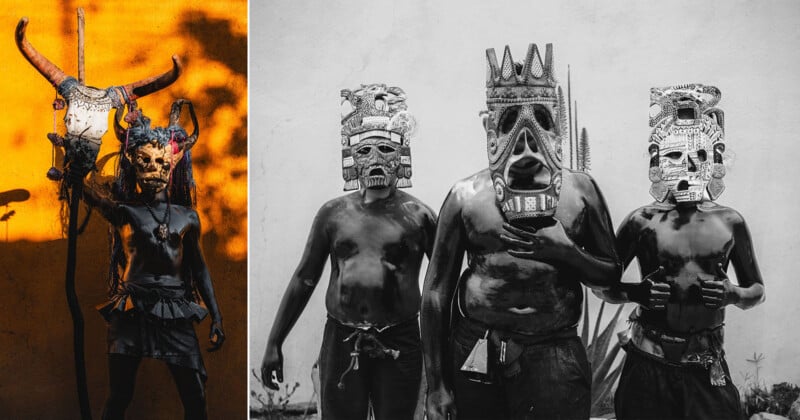
![]()
Puerto Rican photographer and art director Jesse Echevarria ventured to the valleys surrounding Oaxaca, Mexico, to photograph a small but significant ancestral celebration, Diablos de Tilcajete. The event, steeped in the region’s rich history, looks as spectacular as it is challenging to photograph.
The annual Diablos de Tilcajete celebration is unique to the area around Oaxaca, Mexico. To fully appreciate Echevarria’s beautiful photography, a slight historical detour is required.
![]()
![]()
![]()
San Martín Tilcajete, just over 20 kilometers — about 12 miles — outside Oaxaca in southern Mexico, is historically a Zapotec indigenous community, like much of the Octolán district around it — the first settlements in the area date back to 1,150 BCE.
![]()
![]()
![]()
Some smaller villages began to coalesce into larger political entities a few centuries to a millennium later. Although complete details have been lost to time, the region fell under Monte Albán rule around 100 CE, after being under El Mogote rule around 200 BCE. There remains some debate about precise timing, governance, and warfare, but the primary takeaway is that the area has a long, prominent Zapotec indigenous history.
Beginning nearly 1,300 years ago, the most significant urban centers in the region began to fall, with smaller, more fractured settlements popping up in their place. This general scattering of Mixtec people continued until the Spanish Conquest in 1521.
![]()
![]()
![]()
The Spanish colonization had many impacts, including hundreds of thousands of casualties and the widescale destruction of indigenous culture and language. Some of these effects are still felt today in Mexico and worldwide, as the Spanish conquest set off a chain reaction of European conquest across the globe.
Diablos de Tilcajete, even in its 21st-century form, has threads leading back to the conquest.
![]()
![]()
![]()
“Dating back to the times of Spanish colonization, these carnivals held mythical and ancestral significance mixed with a rebellious act of mockery to the imposed Catholic religion by Spanish invaders,” Echevarria explains to PetaPixel.
![]()
![]()
![]()
“To prepare themselves for Cuaresma [also known as lent], a period of 40 days of penance, prayer, and fasting, the Zapotecas created symbolic wedding engagements as an excuse to celebrate and drink before Sunday confession and the upcoming weeks of good Catholic behavior.”
![]()
![]()
![]()
These symbolic weddings included a horde of diablos who marched along the streets, beginning at the bride’s house and working toward the municipal center, festively dancing along the way.
![]()
![]()
![]()
While fun, these elaborate and visually striking Diablo costumes have long held a spiritual and mythical purpose. People don the outfits and masks to protect themselves against bad energy, while their music, generated in part by frenzied cowbells, helps ward off evil spirits.
“Spiritually, they not only cleanse themselves as individuals but also cleanse the whole town, celebrating as a connected community,” Echevarria concludes.
![]()
![]()
![]()
![]()
More from Jesse Echevarria
Echevarria has worked for over a decade as an art director and photographer in the Hispanic market for major agencies like Ogilvy and Dieste. He has created advertising campaigns for international brands like New Balance, Coca-Cola, Goya Foods, and more. He has also worked on campaigns for the United Nations.
He has plenty of experience working with Hispanic and Latin imagery, working in the Hispanic market for major agencies like Ogilvy and Dieste and designing advertising campaigns for international brands like New Balance, Coca-Cola, Goya Foods, and more. He has also worked on campaigns for the United Nations.
To view more of Jesse Echevarria’s brilliant photography, visit his website and follow him on Instagram.
Image credits: All images by © Jesse Echavarria






